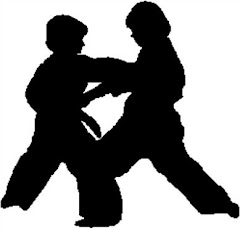Karate Basics
Karate-Do is a japanese martial art, introduced from Okinawa in 1922. In japanese Kara means empty ; Te means hand ; Do means the way, so'Karate-Do' means'the way of the empty hand'. Shuri-Te, Naha-Te, Tomari-Te are the 3 styles of Te ( Hands ) that Karate descended from. Even though it is 'the way of the empty hand', karate equipment for training is involved.
Karate, like jujutsu and judo, most likely came to America thru 2 primary paths : jap immigrants to Hawaii and the mainland, where it stayed mostly inside the japanese Yank community, although to a smaller degree in Hawaii, and by specialized study by members of the police and the army. It might be safe to claim that the biggest boost to the popularization of karate in America came with the american army occupation of Japan after WWII ; once American soldiers had absorbed the discipline, they returned with it to the States and started to distibute it.
Like most martial-arts active in Japan, Karate made its transition to Karate-Do at the start of the 20th century. Karate-Do does not, contrary to its Chinese relatives, include the utilization of weapons. Any weapons used are exactly within the Okinawan tradition, kobudo, the employment of modified farming tools and common implements as weapons, since 'normal' weapons were banned in Okinawa. Within Karate and Karate-Do, there are a great number of different Ryu's ( styles or colleges ). The most renowned are Shaolin ( Shorin-Ryu,'Forest style' ), Shobayashi ('small forest style' ), Kobayashi-ryu ('young forest style' ), Matsubayashi-ryu, ('pine forest style' ), Matsumura Seito ('Orthodox Style' ) and Matsumura Motobu ('Street Style' ). From these came the more favored styles we have today like Shorinji-ryu ( Kempo ) and Shorei-ryu as well as Shotokan ('pine wave' ) and Goju ryu ('hard-soft way' ) also Kyokushin ('ultimate truth' ). Other main line styles are Seido, Wado Ryu ('way of peace' ), Uechi Ryu, and Shito ryu as well as Isshin-ryu. Some styles of karate have teachers that have created hybrids of karate styles like JIKC style which uses a combination of karate styles.
The Shotokan style of Karate is characterized by deep, long stances to provide stability and robust movements. At the other end of the spectrum, Wado-Ryu ('way of peace' ) prefers quick and refined body movements ( known as 'tai sabaki' ) to dodge attacks and swift counter attacks. The Wado-Ryu style was introduced to the west by Sensei Tatsuo Suzuki.
Karate is a hard martial art and emphasises striking techniques ( i.e. Slapping and kicking ) over grappling. Karate can be split into 2 major parts, kumite and kata. Kumite means sparring and develops from well outlined forms to the free form named randori. Kata means forms and is a fight againt imaginary enemies, it is a fixed sequence of moves.
Karate is also a competetive sport although, unlike taekwondo and judo it is not yet an olympic sport. Competition can be in either Kumite or Kata and either as an individual or a team.
Yakusoku Kumite, starts at Green Belt ( Yon-Kyu ) 2 opponents usually square off and fight till a clean point is scored as indicated by one of 2 seated judges by colored flags or seen by the standing referee. At this point sparring is stopped and the point is awarded. Points systems vary but in general a half point ( wazari ) is awarded for a single punch or for a kick to the body. A full point ( ippon ) is given for an attack such as a head kick, any attack following the adversary being brought to the ground or a combination strategy ( renrakuwaza ).
Jiyu Kumite can look more of a fight or street fight. It's the more heavy side of the martial arts being done more for defense or close combat'Real Time' training than for sport. Though every methodology should be controlled, the wrestlers do push themselves to be their best ( No points are awarded ).
In Kata points are awarded by five seated judges similar to either gymnastics or ice skating contests depending on the quality of the performance. A good Kata performance should perform all of the movements properly but also show a personal interpretation of the movements through one's variation in speed. When Kata is performed as a team ( usually of 3 ), it's also vital to match the timing of strategies as closely as possible.
In Kumite there are 2 fighters paired up in a timed fight, customarily starting from 2 to 5 minutes. Score is awarded either by methodology or location.
In the U. S. karate tournaments are a well-liked part of karate as a sport, ranging in size from small local gatherings to countrywide events. They're often split into classes by ability, age and event type ( Kata, Kumite and weapons-kata ), and have rules depending on location and the chief style ( s ) involved.








